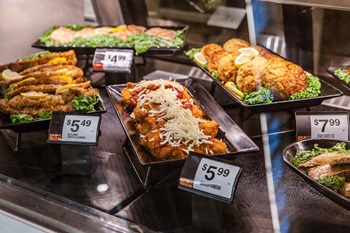By: Rick Stein, Vice President, Fresh Foods, Food Marketing Institute

You’re on your way home from work and realize you didn’t plan anything for dinner. As panic starts to set in you realize you have to make a choice—do you stop off at the grocery store to pick up some quick meal solutions or do you go out to eat?
New research from FMI and Technomic, The Sophistication of Supermarket Fresh Prepared Foods, finds that as supermarkets become increasingly skilled in food service, this decision for shoppers becomes more complex. The study details the sophistication of supermarket fresh prepared foods among 28 banners, representing 8,000 stores, and substantiates the $15 billion growth of supermarket fresh prepared foods over the last eight years. The study finds that most stores (64 percent) witnessed 2014 prepared foods category growth of nine percent or higher.
Here are the top 10 in-depth findings from the report.
 1. Supermarket fresh prepared foods grew by an annual rate of 10.4 percent between 2006 and 2014 making it one of the highest performing segments in the entire food industry.
1. Supermarket fresh prepared foods grew by an annual rate of 10.4 percent between 2006 and 2014 making it one of the highest performing segments in the entire food industry.
2. While only 8 percent of responding supermarkets reported total store sales growth of more than 5 percent in 2014, 69 percent reported that same level of growth (or much higher) in their prepared foods department.
3. Clear lines of delineation can be observed between supermarket chains based on their prepared foods strategies and execution.
4. Professionally-trained chefs are being tasked with contemporizing the prepared foods menus of leading supermarket chains and 88 percent of banners now employ a corporate executive chef.
5. Significant numbers of supermarkets are now offering in-store amenities such as café seating, Wi-Fi, and adult beverage sampling to complement their prepared foods programs.
6. In an attempt to replicate a restaurant-style experience, 23 percent of responding supermarkets report having re-modeled deli departments in the past three years.
7. Managing a deli profit and loss is commonplace, but 43 percent of responding supermarkets indicate that they also manage a separate prepared foods profit and loss.
8. Another sign of increasing sophistication is supermarkets’ reduction in prepared foods SKUs (over half offer fewer than 50 items) while still accommodating the shopper desire for variety.
9. While prepared foods growth rates can be expected to stabilize, the segment will continue to be considered high-growth in comparison to virtually all other retail food and traditional foodservice segments.
10. Prepared foods competition will intensify as most leading supermarkets make continuing long-term investments and as traditional foodservice operators (namely restaurants) aggressively counter this threat to their business.
For the full study and more research on fresh foods in food retail, visit www.fmi.org/FreshFoods.


 Industry Topics address your specific area of expertise with resources, reports, events and more.
Industry Topics address your specific area of expertise with resources, reports, events and more.
 Our Research covers consumer behavior and retail operation benchmarks so you can make informed business decisions.
Our Research covers consumer behavior and retail operation benchmarks so you can make informed business decisions.
 Events and Education including online and in-person help you advance your food retail career.
Events and Education including online and in-person help you advance your food retail career.
 Food Safety training, resources and guidance that help you create a company food safety culture.
Food Safety training, resources and guidance that help you create a company food safety culture.
 Government Affairs work — federal and state — on the latest food industry policy, regulatory and legislative issues.
Government Affairs work — federal and state — on the latest food industry policy, regulatory and legislative issues.
 Get Involved. From industry awards to newsletters and committees, these resources help you take advantage of your membership.
Get Involved. From industry awards to newsletters and committees, these resources help you take advantage of your membership.
 Best practices, guidance documents, infographics, signage and more for the food industry on the COVID-19 pandemic.
Best practices, guidance documents, infographics, signage and more for the food industry on the COVID-19 pandemic.
